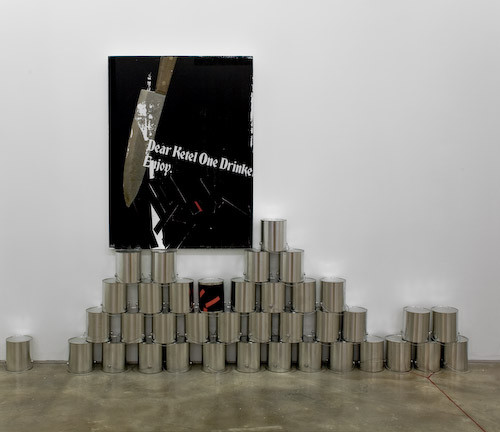No Bees, No Blueberries
26 Jun - 30 Jul 2009

Untitled (from the series: Guyton \ Walker: Empire Strikes Back) , 2006
Silkscreen and digital inkjet print on canvas, 38 paint cans, 1 digital inkjet print on canvas
Overall dimensions variable
June 26 – July 30, 2009
Opening Reception: Friday, June 26th, 6-9 pm
Gallery Hours: Tuesday through Friday, 11am – 6pm
John Baldessari, Andrea Blum, Douglas Boatwright, Kim Seob Boninsegni, The Bruce High Quality Foundation, Heman Chong, Martha Colburn, Ann Craven, Das Institut (Kerstin Braetsch & Adele Roeder), Nikolas Gambaroff, Nicolás Guagnini, Guyton/Walker, Karl Haendel, Gareth James (with Roe Ethridge), i-cabin, Haley Mellin, Olivier Mosset, Steven Parrino, Luciano Perna, Allen Ruppersberg, SALOON (with Debo Eilers, Jane Jo, Jason Loebs, Charles Mayton, Blake Rayne, Georgia Sagri, Thomas Torres Cordova, Viola Yesiltac), Karin Schneider, Peter Simensky (with Charlotte Beckett, Patty Chang, Jennifer Cohen, Rachel Foullon, James Hyde, The Invisible Glove, Daniel Lefcourt, Michael Mahalchick, Ohad Meromi, Carter Mull, Adam Putnam, Allison Smith, Meredyth Sparks, Jane Virga) Curated by Sarina Basta and Tyler Coburn
Harris Lieberman is pleased to present No Bees, No Blueberries, an exhibition of work from over forty multigenerational artists.
No Bees, No Blueberries takes its title from a playful observation, made by artist Andrea Blum, linking the low yield of blueberries last summer to a decline in the bee population. Over the centuries, various communities have attempted to explain the cyclical disappearance and rehabilitation of bees by the preoccupying issues of the times, from the recent concern with global climate change and the predominance of synthetic insecticides, in the 1960s, to a 19th century theory of the “low moral fiber” of the insects themselves.
Bees occupy many a human metaphor, as well as everyday expressions like “the bee’s knees” and “busy bee,” reminding us of the productive and socialized energies inside and outside the hive. The insect attracts champions and critics alike: Einstein promoted the bee’s foundational role in the life-chain, given that pollination effects one-third of human and animal food supply; Nietzsche, in On the Genealogy of Morals, indicted the “worker bee” mindlessly toiling away within a vast enterprise; and recent theories address the insect as an agent of transmission, dissemination, replication and reproduction, cross-pollinating plants and flowers in a generative, promiscuous, and sexually hybrid manner.
In the midst of an economic moment that increasingly draws focus to the top-down frailty of the art world, No Bees, No Blueberries investigates the artist, her resilience, her capacity for self-organization and the flexibility of her communities. Many of the exhibiting artists pair formal pursuits with meditations on social structures. Among them, Peter Simensky, Nikolas Gambaroff and SALOON employ sub-curated artworks and performances that call conventional delineations of production into question. Nicolás Guagnini, Heman Chong and Kim Seob Boninsegni assemble visual lexicons from the material and rhetorical fragments of exhibition posters and propaganda. John Baldessari’s shallow-relief sculptures and Ann Craven’s fluttering birds offer representations of the organic and programmatic forces at play throughout the exhibition.
A series of performances and events will run concurrently with No Bees, No Blueberries, with contributions from B’Ling, Cleopatra’s, The Bruce High Quality Foundation and others.
